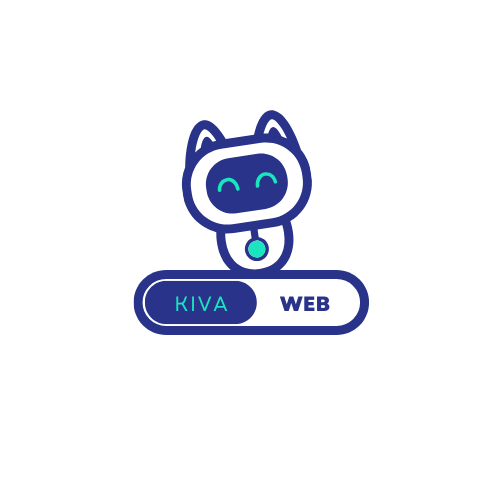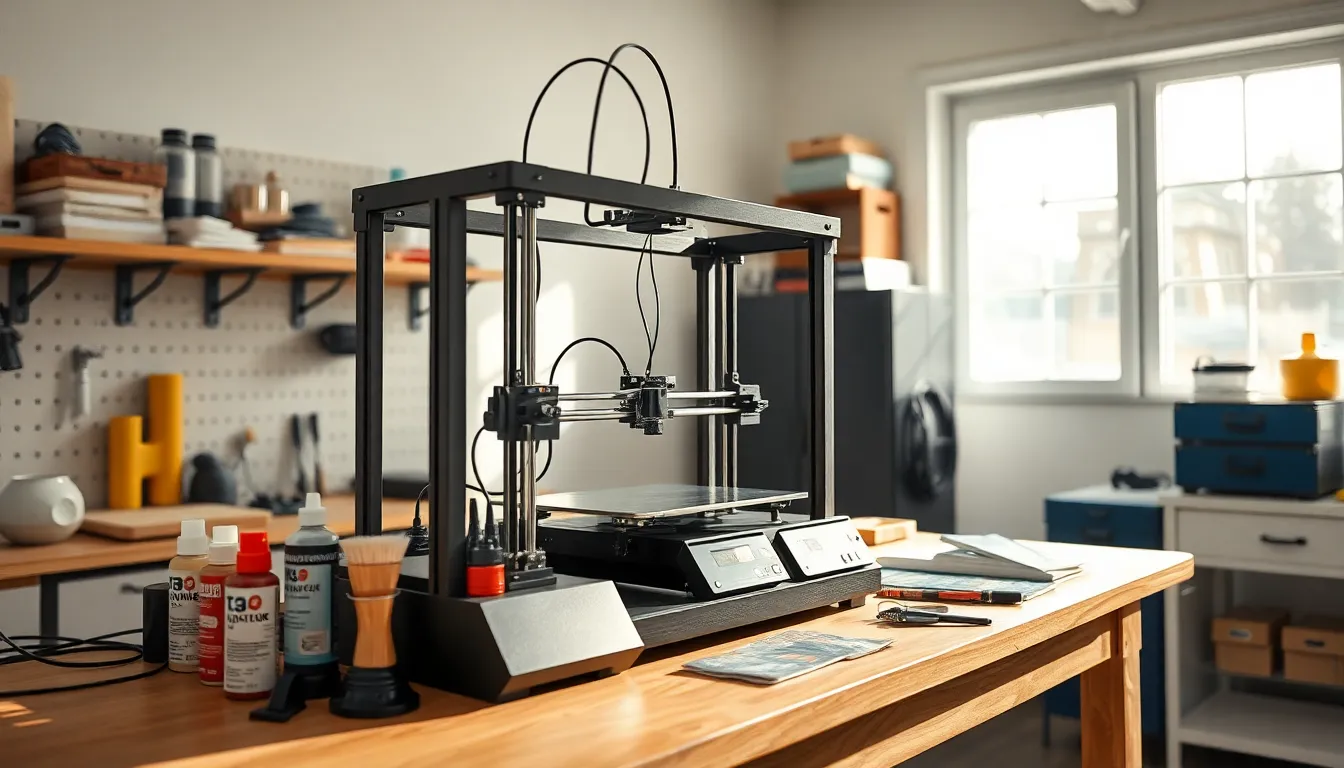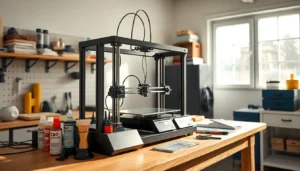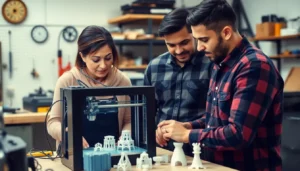In a world where ideas swirl like confetti at a party, turning a brilliant concept into a tangible product can feel like trying to catch smoke with your bare hands. Enter functional prototyping—the superhero of product development. It’s the magic wand that transforms wild ideas into something you can actually poke, prod, and test.
Table of Contents
ToggleOverview of Functional Prototyping
Functional prototyping serves as a critical phase in product development. This method facilitates the transformation of abstract ideas into concrete models, allowing for real-world testing and evaluation. During this process, designers create prototypes that accurately represent specific functionalities of a product, enabling teams to identify potential issues early.
Multiple types of functional prototypes exist, including low-fidelity and high-fidelity options. Low-fidelity prototypes often consist of simple sketches or digital wireframes. High-fidelity prototypes, however, resemble the final product closely, incorporating advanced technology and materials.
Testing these prototypes provides invaluable feedback. Users can interact with the prototypes to assess usability, identify flaws, and suggest improvements. Gathering user insights significantly enhances the design process, resulting in products that align more closely with market needs.
In addition to user testing, functional prototyping also supports collaboration among team members. Developers, designers, and stakeholders can visualize concepts and discuss potential changes effectively. This collaborative approach promotes innovation and fosters creativity throughout the design process.
Overall, functional prototyping represents a strategic investment in product development. By prioritizing tangible outputs, teams can enhance their offerings and streamline workflows, ultimately leading to successful product launches in competitive markets.
Benefits of Functional Prototyping
Functional prototyping offers significant advantages in product development. These benefits ensure a more effective design process, ultimately leading to better market-ready products.
Enhanced User Feedback
Users provide vital insights during testing phases. Interacting with functional prototypes, they can assess usability and engage with features. Feedback reveals strengths and weaknesses, guiding adjustments early in the design process. Positive user experiences highlight successful design aspects, while negative feedback indicates areas needing improvement. This iterative process enhances the product’s alignment with user needs, fostering satisfaction and usability. Prioritizing user feedback not only refines the design but also strengthens market fit. Gathering user insights early reduces costly revisions later.
Improved Design Validation
Designers validate concepts through functional prototypes. These prototypes simulate real-world functionality, enabling evaluation against initial requirements. Testing functionality helps identify discrepancies between design intent and practical application. Early detection of issues prevents significant setbacks in later development stages. By emphasizing validation, teams can ensure prototypes meet business objectives and user expectations. Successful validation leads to confidence in design decisions, guiding further development with clearer direction. Ultimately, improved design validation minimizes risks associated with product launches and enhances overall project success.
Techniques for Functional Prototyping
Functional prototyping includes various techniques that help bring ideas to life through tangible representations. Two main approaches are physical prototyping and digital prototyping.
Physical Prototyping
Physical prototyping involves creating three-dimensional models to showcase a product’s form and function. Designers frequently use materials like cardboard or plastic to build these prototypes. Physical prototypes enable users to interact with products in a hands-on manner, providing immediate feedback on ergonomics and usability. Teams can assess the prototype’s practical aspects, fostering deeper insights into potential design modifications. By using physical prototypes, stakeholders can visualize concepts more clearly, leading to better-informed decisions and accelerated iterations.
Digital Prototyping
Digital prototyping focuses on creating virtual representations of products through software tools. Designers utilize platforms like Sketch or Adobe XD to develop clickable wireframes and interactive mockups. These digital models provide a quick way to test user interfaces and workflows before physical production. Feedback gathered during digital prototyping can be valuable for identifying usability issues early in the design process. Additionally, rapid revisions become easier with digital prototypes, allowing teams to adapt based on testing results without the costs associated with physical changes. This technique emphasizes collaboration across disciplines, enhancing overall project efficiency.
Challenges in Functional Prototyping
Functional prototyping presents several challenges that can impact the development process. Time constraints often pressure teams to deliver prototypes quickly, which can compromise quality and thorough testing. Limited resources, such as budget and materials, affect the ability to create high-fidelity prototypes that accurately reflect final products.
Communication barriers may arise when team members from different disciplines collaborate. Misunderstandings can lead to divergent expectations about a prototype’s functionalities. Diverse perspectives are valuable but can complicate project alignment if not managed properly. Additionally, incorporating user feedback effectively is crucial. Despite collecting engaging insights, translating this feedback into actionable design changes remains difficult.
Technological limitations also play a role in functional prototyping challenges. Some teams use outdated tools or lack access to advanced prototyping technologies, resulting in missed opportunities for innovation. Rapid prototyping techniques enable quicker iterations and adaptations. However, without the right tools, teams struggle to realize the full potential of their concepts.
Evaluating the balance between fidelity and functionality presents another significant challenge. High-fidelity prototypes provide detailed insights but require more time and resources, while low-fidelity options might not convey the intended user experience effectively. Striking the right balance is essential for drawing meaningful conclusions during testing phases.
Lastly, managing user expectations poses a challenge as well. Users may form opinions based on early prototypes that do not yet represent the final product. Misinformation can create unrealistic expectations regarding functionality. Ensuring clear communication throughout the prototyping process helps mitigate these potential pitfalls, ultimately enhancing design and development outcomes.
Future Trends in Functional Prototyping
Emerging technologies shape the landscape of functional prototyping, enhancing speed and accuracy. Advanced printing techniques, including 3D printing and additive manufacturing, enable rapid production of complex geometries. These methods allow designers to create high-fidelity prototypes that reflect actual products closely.
Increased integration of augmented reality (AR) and virtual reality (VR) enhances user engagement during testing. Users interact with prototypes in immersive environments, gaining deeper insights into usability and design. This shift facilitates real-time feedback and fosters more informed decision-making.
Artificial intelligence (AI) plays a crucial role in optimizing prototype design and testing processes. AI algorithms analyze user data, identifying patterns and suggesting improvements, streamlining iteration cycles. Consequently, teams can focus on refining designs based on actionable insights.
Sustainability also gains importance in functional prototyping. Eco-friendly materials and processes are being prioritized, addressing environmental concerns while maintaining quality. This trend aligns with growing consumer demand for sustainable products.
Collaboration tools evolve, improving communication among team members. Cloud-based platforms enable real-time updates, allowing cross-functional teams to collaborate effortlessly. Such tools bridge gaps between different disciplines, enhancing the efficiency of the design process.
Finally, increased emphasis on user-centered design drives functional prototyping efforts. Engaging users early and continuously throughout the process leads to products that better meet market needs. This approach minimizes costly revisions and ensures alignment with user expectations.
Overall, these trends signify a shift toward more agile, collaborative, and sustainable practices in functional prototyping, aligning with industry demands and consumer preferences.
Conclusion
Functional prototyping stands as a pivotal step in the product development journey. By bridging the gap between ideas and tangible products, it empowers teams to iterate and refine designs effectively. The collaborative nature of prototyping fosters innovation and ensures that products align with user needs and market demands.
As technology continues to advance, the future of functional prototyping looks promising. Embracing new techniques and tools will enhance the efficiency and effectiveness of the design process. Ultimately, investing in functional prototyping not only streamlines workflows but also leads to more successful product launches in an increasingly competitive landscape.










